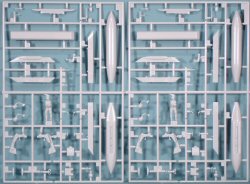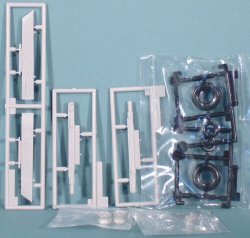
Hasegawa 1/48 F-14B Tomcat Kit First Look
By Michael Benolkin
| Date of Review | February 2006 | Manufacturer | Hasegawa |
|---|---|---|---|
| Subject | Grumman F-14B Tomcat | Scale | 1/48 |
| Kit Number | 09639 | Primary Media | Styrene |
| Pros | Still the best Tomcat kit in any scale | Cons | Flash problems from aging molds, bait and switch box art, over-engineered for the average modeler |
| Skill Level | Intermediate | MSRP (USD) | $62.98 |
First Look
 |
 |
 |
 |
 |
 |
 |
 |
 |
 |
The F-14A entered the fleet as the Navy's most versatile fleet interceptor and dogfighter, but it lacked one attribute that would have made a significant difference in its operational history - more thrust. The TF30 engines that powered the F-14A were left over from the F-111B program and were experiencing rather spectacular failures that resulted in the loss of a number of F-111s and F-14As. Nevertheless, with TF30 power, the F-14A could out-turn any other aircraft produced (prior to the F-16) in the first 180 degrees of the turning fight, and this included the new F-15 Eagle as well. After 180 degrees of turn, the Tomcat had insufficient thrust to sustain the turn rate. Recognizing the potential that the F-14 offered, the Navy sought engine alternatives.
The first F-14B was test-flown in 1973 with the Pratt & Whitney F401 engines, a derivative of the F-15's F100 engine. While flight testing was promising, the program was shelved. In 1981, the F-14B prototype was dusted off and re-engined, this time with the General Electric F101DFE. The F101 was the engine that powered the B-1 bomber and the DFE (Derivative Fighter Engine) program was an attempt to provide an alternative power source for the troublesome Pratt & Whitney F100 engine that powered both the F-15 and F-16. After a series of evaluations, the F-14B was mothballed again.
The result of the F101DFE was the F110 that powers the F-16 Blocks 30, 40, 50, and 60 as well as export versions of the F-15E. The Navy once again dusted off the F-14B prototype and evaluated the F110-GE-400 engine in 1984 and by 1986, the go-ahead for re-engining a portion of the F-14A fleet was given. Unlike the TF30, the F110 had virtually unconstrained throttle range without worries of compressor stalls and would sustain the Tomcat through the turning fight as well.
The Hasegawa 1/48 Tomcat kit is the best F-14 in any scale to date. In the initial releases many years ago, there was a tricky design problem that prevented a the intake trunks from simply dropping into place on the lower fuselage half. I know I dumped one of these kits in the trash after running head-long into this problem myself out of sheer frustration. Hasegawa has long-since corrected the problem. Aside from that issue, the kit literally falls together.
The kit is molded in light gray styrene and presented on eight parts trees, plus a single tree containing the clear parts. This kit set the bar rather high when it was first released with the quality of its finely scribed detailing. Kits releaseed today are still measured against this standard.
What makes this kit recommended for intermediate modelers is the level of detail in the box. There is quite a bit of work here to build this aircraft and someone wanting a simpler Tomcat to start with is better off with the Academy 1/48 F-14A Tomcat or F-14A Bombcat kits. What you'll find in this box can only be found in one other Tomcat kit and that's Hasegawa's own 1/72 F-14 series - dropped flaps and slats. These are the only kits that allow the Tomcat to be posed with everything hanging out.
Another big plus with this kit is the engine detail. The TF30 parts from the F-14A release are replaced with F110 parts, and once again, this is the only 1/48 Tomcat to get the scale length of the afterburner chambers right. The kit comes with engine faces for viewing down the intakes and turbine faces for viewing down the tailpipes. You have your choice of open or closed engine nozzles for the GE just as you did with the TF30 nozzles in the Hasegawa F-14A kit. The only detail missing here are the afterburner spray rings that sit aft of the turbine faces to inject fuel for the afterburning augmentation (hence the name). These are available (I believe) in the Eduard photo-etch detail sets for this kit.
Among the options available in the kit, the wings can be positioned full-forward or fully aft (not overswept); the flaps and slats can be positioned up or down; the engine nozzles can be positioned open or closed; the speed brakes can be positioned open or closed; and optional crew figures are also included. Evidently there is no longer a choice between styrene and rubber tires - the latter is standard with white metal wheel hubs.
External options for the kit include Phoenix pallets for the underside of the fuselage, external fuel tanks for under the intake trunks, and a TARPS reconnaissance pod. This release also includes updated pylons for the wing gloves, but that is it. This kit follows the philosophy Hasegawa developed years ago that mandates that you purchase separate weapons sets to arm your kit.
Now for the downside. First, these molds are starting to show their age and are in need of some maintenance. You can see flash starting to build up on many of the parts trees and this translates into more work and some detail damage when you clean up the flash. Inspect your kit before buying if you can.
Second, Hasegawa has been engaged with what I'll call a bait and switch approach to box art. I don't know about you, but when I see box art, I assume what I see portrayed is what I'll get in the box. The box art in this case is a very contemporary VF-102 F-14B in the 'Bombcat' configuration. If you look at the box art, you see the LITENING pod under the right wing glove pylon, the bomb racks built into modified Phoenix pallets, and even an ACMI pod. What comes in the box are standard pallets, no LITENING pod, nor ACMI pod. While they do include the special-purpose pylon adaptor for the LITENING and updated AIM-9 rails, they don't include the rest of the Bombcat parts and these are NOT available in their weapons sets. Ironically, Hasegawa has released the pod and Bombcat pallets in the past Tomcat releases.
It this were an isolated incident, fair enough, but Hasegawa practices the 'bait and switch' periodically. There was a special marking issue of their F-16 in 1/48 and on the box was a nice photo of the F-16A MLU in special markings, but what was in the box was a vanilla F-16A (no MLU parts) with the requisite decals. I could cite other examples of this practice, but let me sum this up with a word of advice. Hasegawa kits are some of the nicer models on the market, but if you're looking for a specific version of one of their aircraft, check the contents of the box to ensure that what you're looking for is there.
Markings are included for three F-14B examples (okay, same airplane over three years):
- F-14B, BuNo 163225, VF-102. AB/102, 2000, CAG aircraft
- F-14B, BuNo 163225, VF-102. AB/102, 2001, CAG aircraft during OIF
- F-14B, BuNo 163225, VF-102. AB/106, 2002
As always, the Hasegawa 1/48 scale Tomcat is hands-down the best quarter-scale 'cat on the market today. While over-engineered for the quick-build project, this kit builds into a nice rendition of the F-14 in experienced hands. The more recent flash problems may pose additional challenges, so check your kit carefully before taking it home. Lastly, no matter which version of the F-14 you do opt to purchase, be sure it has any optional parts you might expect from the label or box art before you buy. If it says or shows a Bombcat, it should have the parts for that version in the box.








